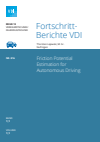Zusammenfassung
Autonomous vehicles need information about the environment for trajectory planning. This information is usually stored in a high-definition map. This map is made available to the vehicle. This thesis deals with the friction potential, which is important for planning. The unitless value determines the maximum forces that can be transmitted between tyre and road. The friction potential is a function of many influencing factors. In this work, possibilities are evaluated to capture the most important of these influencing factors, the road surface and the intermediate layer, via external data sources. To determine the influence of the road surface, friction measurement methods established in road construction are compared with vehicle measurements. To determine the intermediate layer, data from weather stations, rain radar and a test vehicle are evaluated.
Contents
Abbreviations VIII
Symbols X
Abstract XVI
Kurzfassung XVIII
1 Introduction 1
1.1 Motivation . . . . . . . . . . . . . . . . . . . . . . . . . . . . . . . . . . . 2
1.2 State of the Art . . . . . . . . . . . . . . . . . . . . . . . . . . . . . . . . 11
1.2.1 Friction Potential Measurement Methods . . . . . . . . . ....
Schlagworte
Autonomes Fahren Klassifizierungsverfahren Reifen autonomous driving Trajektorienplanung Straßenbau Reibwert Straßenwetter Tyre Friction Trajectory Planning Road Maintenance Classification Methods- Kapitel Ausklappen | EinklappenSeiten
- 1–35 1 Introduction 1–35
- 81–103 4 Grip Map 81–103
- 136–138 7 Conclusions 136–138
- 139–154 Appendix 139–154
- 155–174 Bibliography 155–174

